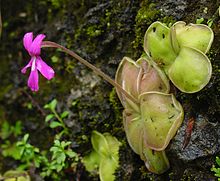Pinguicula
| Pinguicula | |
|---|---|
 |
|
| Pinguicula moranensis | |
| Scientific classification | |
| Kingdom: | Plantae |
| (unranked): | Angiosperms |
| (unranked): | Eudicots |
| (unranked): | Asterids |
| Order: | Lamiales |
| Family: | Lentibulariaceae |
| Genus: |
Pinguicula L. |
| Species | |
|
About 80, see separate list. |
|
About 80, see separate list.
Pinguicula, commonly known as the butterworts, is a genus of carnivorous plants that use sticky, glandular leaves to lure, trap, and digest insects in order to supplement the poor mineral nutrition they obtain from the environment. Of the roughly 80 currently known species, 12 are native to Europe, 9 to North America, and some in northern Asia. The largest number of species is in South and Central America.
The name Pinguicula is derived from a term coined by Conrad Gesner, who in his 1561 work entitled Horti Germaniae commented on the glistening leaves: "propter pinguia et tenera folia…" (Latin pinguis, "fat"). The common name "butterwort" reflects this characteristic.
The majority of Pinguicula are perennial plants. The only known annuals are P. sharpii, P. takakii, P. crenatiloba, and P. pumila. All species form stemless rosettes.
Butterworts can be divided roughly into two main groups based on the climate in which they grow; each group is the further subdivided based on morphological characteristics. Although these groups are not cladistically supported by genetic studies, these groupings are nonetheless convenient for horticultural purposes. Tropical butterworts either form somewhat compact winter rosettes composed of fleshy leaves or retain carnivorous leaves year-round. Temperate species often form tight buds (called hibernacula) composed of scale-like leaves during a winter dormancy period. During this time the roots (with the exception of P. alpina) and carnivorous leaves wither. Temperate species flower when they form their summer rosettes while tropical species flower at each rosette change.
...
Wikipedia
